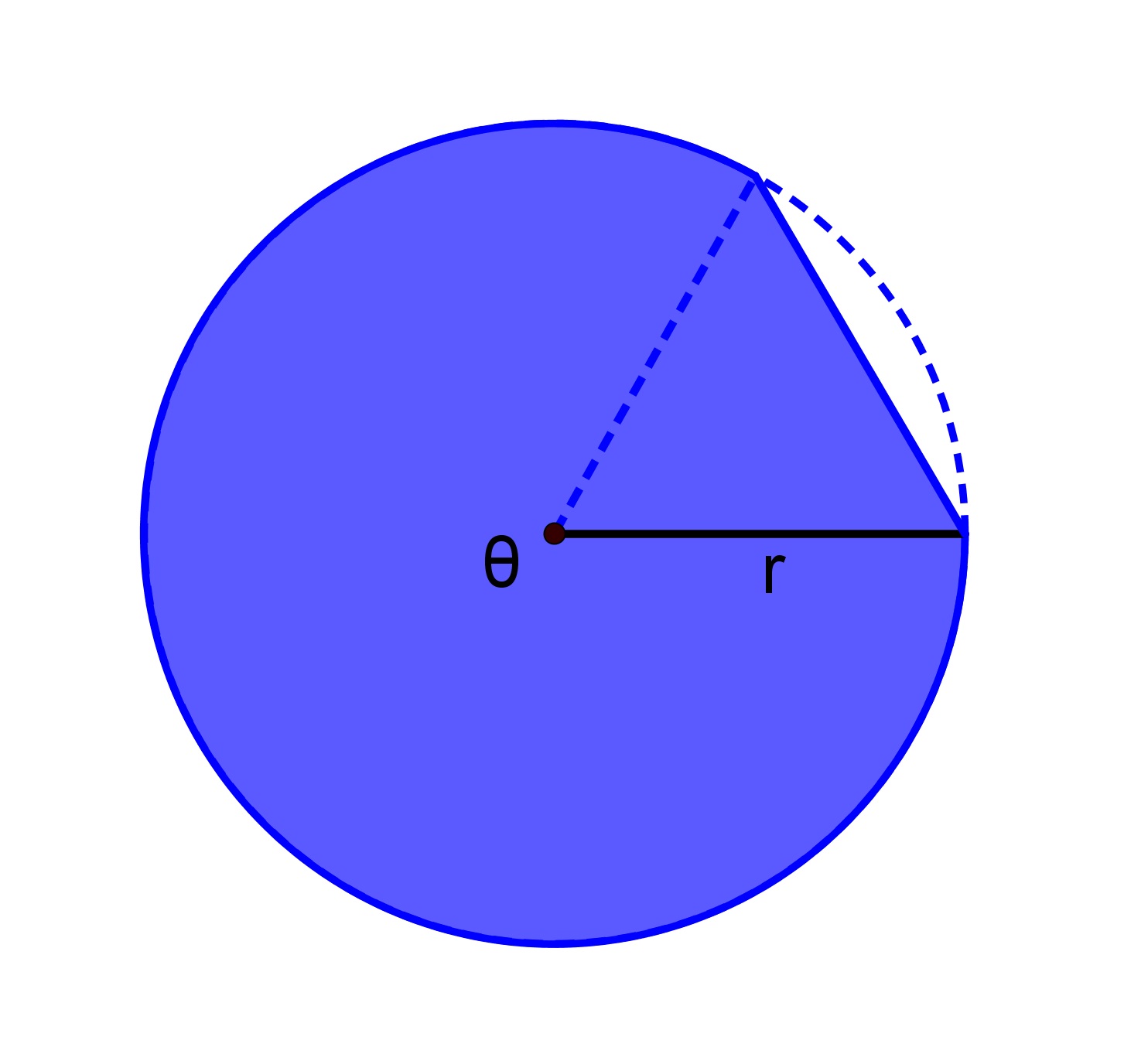
Areas of Segments (radians)
Quick Recap
We now know that the area of a circle is $\pi r^2$πr2. We also now know that the area of a sector is some fraction of that full area $\frac{\theta}{2\pi}\times\pi r^2=\frac{1}{2}r^2\theta$θ2π×πr2=12r2θ. The fraction is the proportion of $2\pi$2π that the sector's angle at the centre takes up.
Recall that there is a minor sector and a major sector associated with any given angle at the centre. The other sector can simply be found by using $2\pi-\theta$2π−θ in the formula for the area of a sector.

$Area=\pi r^2$Area=πr2
 |
 |
| $Area=\frac{1}{2}r^2\theta$Area=12r2θ | $Area=\frac{1}{2}r^2\left(2\pi-\theta\right)$Area=12r2(2π−θ) |
 |
 |
| $Area=\frac{1}{2}r^2\left(2\pi-\theta\right)$Area=12r2(2π−θ) | $Area=\frac{1}{2}r^2\theta$Area=12r2θ |
Area of a Minor Segment
What about the area of a segment? Remember that a segment is the region bounded by a chord and the arc subtended by the chord (a chord is an interval connecting two points on a circle).

This may seem very difficult to do, until we realise that the area of a minor segment is just the area of a sector minus the area of a triangle.
 |
|
 |
 |
|
| $\frac{1}{2}r^2\theta$12r2θ | $\frac{1}{2}r^2\sin\theta$12r2sinθ | $\frac{1}{2}r^2\theta-\frac{1}{2}r^2\sin\theta$12r2θ−12r2sinθ |
Here we got the area $\frac{1}{2}r^2\sin\theta$12r2sinθ of the triangle from our formula $Area=\frac{1}{2}ab\sin C$Area=12absinC.
For a segment which subtends an angle $\theta$θ at the centre of a circle:
$\text{Area of a segment}$Area of a segment$=$=$\frac{1}{2}r^2\theta-\frac{1}{2}r^2\sin\theta$12r2θ−12r2sinθ$=$=$\frac{1}{2}r^2\left(\theta-\sin\theta\right)$12r2(θ−sinθ)
Area of a Major Segment
How do we find the area of a major segment? In fact, the formula above will still hold. Let's see why.
The area of a major segment is just the area of the major sector, which subtends angle $\theta$θ, plus the area of a triangle with angle $2\pi-\theta$2π−θ.
 |
|
 |
 |
|
| $\frac{1}{2}r^2\theta$12r2θ | $\frac{1}{2}r^2\sin\left(2\pi-\theta\right)$12r2sin(2π−θ) | $\frac{1}{2}r^2\theta+\frac{1}{2}r^2\sin\left(2\pi-\theta\right)$12r2θ+12r2sin(2π−θ) |
However, since $\sin\left(2\pi-\theta\right)=-\sin\theta$sin(2π−θ)=−sinθ, from the symmetry of the sine function, this is the same as our original formula:
| $\text{Area of segment}$Area of segment | $=$= | $\frac{1}{2}r^2\theta+\frac{1}{2}r^2\sin\left(2\pi-\theta\right)$12r2θ+12r2sin(2π−θ) |
| $=$= | $\frac{1}{2}r^2\theta-\frac{1}{2}r^2\sin\theta$12r2θ−12r2sinθ | |
| $=$= | $\frac{1}{2}r^2\left(\theta-\sin\theta\right)$12r2(θ−sinθ) |
Alternatively, if we have already calculated the area of the minor segment we can subtract this from the area of the circle to find the area of the corresponding major segment.
 |
|
 |
 |
|
| $\pi r^2$πr2 | $\frac{1}{2}r^2\left(\theta-\sin\theta\right)$12r2(θ−sinθ) | $\pi r^2-\frac{1}{2}r^2\left(\theta-\sin\theta\right)$πr2−12r2(θ−sinθ) |
Examples
Question 1
The diagram shows a circle with radius $8$8 units, and chord $AB$AB subtending an angle of $\frac{\pi}{3}$π3 radians at the centre.
Find the exact area of the minor segment cut off by chord $AB$AB. Fully simplify your answer.

Question 2
In the diagram, $O$O is the centre of the circle, and sector $OAB$OAB takes up $\frac{4}{9}$49 of the circle.
Find the area of the minor segment cut off by chord $AB$AB correct to one decimal place.

Question 3
Consider a circle with centre $O$O and a chord $AB$AB subtended by an angle of $\theta$θ radians at the centre. The radius is $30$30 cm and the area of sector $OAB$OAB is $75\pi$75π cm2.
Solve for $\theta$θ, the angle at the centre.
Find the area of the minor segment cut off by chord $AB$AB.
Find the area of the major segment cut off by chord $AB$AB.
Determine the exact ratio of the area of the major segment to the area of the minor segment.